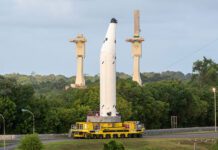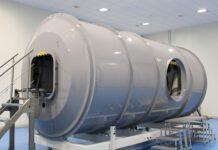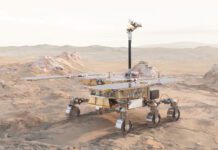
As ESA astronaut Luca Parmitano’s passionate speech at the European Space Summit 2022 in Toulouse once again ignites the question of whether or not Europe should develop independent crew launch capabilities, we have some thoughts.
If European governments and industry are to develop crew launch capabilities, national pride is never going to be enough. There needs to be a commercial application for the technology to ensure a strong financial incentive. We just don’t have the funding capacity to spend billions on what is essentially a vanity project.
So, is there a future for commercial crew launches? Well, there are several companies pursuing short stints in space for the ultra wealthy. This, in our opinion, is never going to offer long-term financial stability. For that, Europe needs customers with deeper pockets who are interested in multi-flight contracts. Luckily, such a customer base might very well be on the horizon.
Right now there are several commercial space stations in the works. Axiom Space, Nanoracks, Northrop Grumman and a coalition of companies led by Blue Origin are all developing and have secured funding for commercial space stations. Once operational, customers and tenants of these stations will need a way to get crew and cargo to and from low Earth orbit.
At the moment, only SpaceX, Russia, and China have the means to launch and return a crew from orbit. The beleaguered Boeing may well be added to that roster in the coming year or two but that very much remains to be seen. NASA’s SLS rocket equipped with the Lockheed Martin Orion spacecraft will likely be far too expensive to offer a viable commercial option but with continued government support, it may well still be in the running.
Even if we’re generous and add Boeing and NASA to the list, it is still unlikely that there will be enough capacity to meet the demands of several commercial space stations operating in low Earth orbit at once. This gives the European Space Agency (ESA) and the 22 member states that fund and determine its direction a profit-driven reason to invest in crew launch capabilities. As a proposal to meet that demand, we give you Project Athena.
Project Athena
It is important to state upfront that this proposal is hypothetical and does not include the input or consideration of any of the companies, agencies, or governments I reference.
Project Athena aims to fast track the development of an expendable crew launch system that leans on work being done by Airbus Defence and Space and Thales Alenia Space with the development of the European Service Module (ESM) and Lunar Gateway modules for NASA. Both companies also have heritage in previous European crew launch initiatives including the Crew Space Transportation System and the Automated Transfer Vehicle Evolution initiative.
The spacecraft would have space for a crew of three with both pressurized and unpressurized cargo capabilities. It would have on-orbit capabilities to support three-month missions powered by a pair of deployable solar arrays. Although the trunk would be optimised for low Earth orbit operations initially, a service module more in line with the Airbus Defence and Space ESM could extend its reach beyond low Earth orbit to support crew operations for NASA’s Lunar Gateway space station.
We considered a reusable spacecraft like the SpaceX Crew Dragon as this would reduce operational costs in the long run. However, the complexity you add with reusability would severely slow the project down. Instead of aiming for the whole wish list, we would look to add reusability as a feature of an upgraded vehicle once the original proved itself in the market.
The launch vehicle
In order to launch the Athena crew capsule, a human-rated ArianeGroup Ariane 6 would be utilized. Yes, we know human-rated launch vehicles that utilize solid rocket boosters (SRBs) are controversial. However, it’s important to remember that both NASA’s SLS and United Launch Alliance’s crew-rated Atlas V utilise SRBs. Additionally, Ariane 5 has proven the reliability of European SRBs over more than 100 missions.
By using the Ariane 6, ESA would be able to avoid developing a dedicated launch system from scratch, an effort that would likely take a decade or more. It would also give Arianespace another avenue to market the Ariane 6 when the awarding of launch contracts for the sorts of payloads it was built for are becoming less and less frequent.
The launch vehicle stack would feature a standard escape tower system to be utilized in the event of an emergency. We went with a standard escape tower instead of an integrated system as it can be developed independently while avoiding the need to add that additional complexity to the spacecraft. It is also a system that has proven itself over decades of human spaceflight.
The next step
That leaves two questions. How much will it cost and how are we going to pay for it? The answer to the first question is a significant amount. Putting a euro figure on it is well beyond our capabilities and the answer to the second question is ultimately more important.
Our answer for who is going to pay for it is a European coalition of governments and industry leaders intent on ensuring the continent’s future in space. And we mean that seriously. This will need to be an effort that each and every one of the 22 ESA member states funds and passionately pursues. This is, however, easier said than done.
Europe and the European Space Agency is a tangled web of geopolitics, ego, and pride. Additionally, despite this program aiming to fast track development, it would likely need the support of governments through election cycles while avoiding its expenditure becoming a point of attack for any opposition party looking to score an easy win. As a result, there is another factor that will need to be considered and that’s the support of the general European public.
Traditionally, Europe’s efforts in space have been mostly been ignored by the continent’s general public despite some truly groundbreaking missions. However, as NASA discovered with the Apollo program, there’s nothing that gets the public more excited than seeing a select few of its fellow citizens reach for the stars. And I think it’s never been a better time to lobby the European public to get behind a crewed launch initiative.
As NASA prepares to launch astronauts back to the Moon for the first time since Apollo 17 with the possibility that European astronauts main join them on the surface of the Moon, ESA has the chance to piggyback on that excitement as it heads for two important deadlines.
The first important deadline is the announcement of the newest class of ESA astronauts, a class that saw a record number of applicants. The second is the 2022 ESA ministerial meeting that will be held in Paris in November. This gives the agency the chance to introduce the protagonists of this great story in October before announcing that they’ll be riding to space in a European-built spacecraft in November. It might never have been a better time to get Europeans from every corner of the continent excited about their country’s place among the stars.
So, in 2022 we have the economic motivation to get governments and industry interested and the emotional motivation to get Europe’s general public interested. The time is now!
So, we put this challenge to ESA and its Director General Josef Aschbacher. Let’s get a crew launch initiative up for a vote at the ministerial meeting in November and we will work hard to lobby each and every member state and its citizens to get involved. The time is now!







